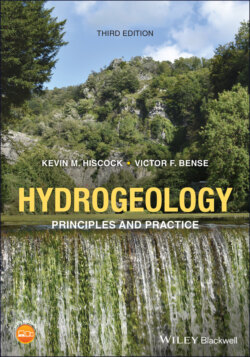Читать книгу Hydrogeology - Kevin M. Hiscock - Страница 31
Box 1.3 The North‐west Sahara Aquifer System and the Ouargla Oasis, Algeria
ОглавлениеThe Sahara Basin covers an area of about 780 000 km2 and includes two sub‐basins separated by the M’zab High. The western sub‐basin occupies about 280 000 km2 and is covered by sand dunes of the Grand Erg Occidental and the eastern sub‐basin extends over about 500 000 km2 and is covered by the desert of the Grand Erg Oriental. The Sahara Basin is underlain by two major aquifers that comprise the Northwest Sahara Aquifer System (NWSAS) of Cretaceous age that extends below Algeria, Tunisia and Libya in North Africa (see Plate 2.7). The Lower Aquifer (the Continental Intercalaire) is composed of continental sandstone alternating with argillaceous layers and the Upper Aquifer (the Complex Terminal) is a multi‐layered aquifer consisting of sandstones and limestones. The thickness of the thicker, more extensive Lower Aquifer ranges between 200 and 1000 m, decreasing north‐eastwards to 125 m. The lower confining unit consists of argillaceous and marly formations of Devonian‐Triassic age while the upper confining units consist of evaporites and clays of Upper Cretaceous age (Zektser and Everett 2004).
In western Algeria, the Lower and Upper Aquifers are almost independent but towards the Mediterranean coast the aquifers become interconnected or merge to form one aquifer system. Groundwater movement in the NWSAS is towards the south and south‐west in the western sub‐basin. In the eastern sub‐basin, where the Complex Terminal aquifer is heavily exploited in Algeria and Tunisia, groundwater flows towards discharge areas, mainly desert depressions or oases known as ‘chotts’. The chotts supply irrigation water through traditional qanat systems (foggaras), with some 570 foggaras discharging about 90 × 106 m3 a−1 (Zektser and Everett 2004).
In the western sub‐basin, the total dissolved solids content of groundwater in the Lower Aquifer ranges from 0.5 to 1 g L−1. In the eastern sub‐basin, salinity increases to 5 g L−1. The concentration of total dissolved solids in the Upper Aquifer is about 2 g L−1 in southern areas of the Grand Erg Oriental, increasing in concentration north‐eastwards from 2 to 5 g L−1 at Tozeur in Tunisia. At Ouargla in Algeria, concentrations reach 8 g L−1 in discharge areas (Zektser and Everett 2004).
Groundwater reserves in the NWSAS are estimated to be 60 000 km3 although, given the low rainfall amount, the aquifer system is generally considered a non‐renewable aquifer system. Use of the superficial water table of the NWSAS extends back to ancient times and, from the middle of the nineteenth century, boreholes were drilled to access deeper parts of the aquifer. In Algeria, exploitation of groundwater from the aquifer system was about 150 × 106 m3 until 1940 since when pumping has increased to about 260 × 106 m3 a−1 (Zektser and Everett 2004). By the 1970s, in the Ouargla Oasis of northern Algeria, there were approximately 2000 boreholes developed in the NWSAS in order to irrigate date palms (see Plate 1.6). In southern Tunisia, exploitation of the Complex Terminal aquifer increased from 9 × 106 m3 a−1 in 1900 to about 190 × 106 m3 a−1 in 1995. The impact of this intensive development on the aquifer system has been observed in discharge areas. In Algeria, the flow of springs decreased from 200 L s−1 in 1900 to 6 L s−1 in 1970, whereas in Tunisia, the flow from springs decreased from 2500 L s−1 in 1900 to virtually nil (less than 30 L s−1) in 1990 (Zektser and Everett 2004). Traditional irrigation methods in the region used sustainable quantities of water, but the more intensive modern irrigation methods used at present have led to a degraded water quality, decreased water levels and loss of artesian pressure, as well as salinization of the superficial water table and soil zone due to the drainage conditions. This salinized water is typically at a depth of 0.5–1.5 m below the soil surface and is detrimental to date palms (UNEP 2008).
